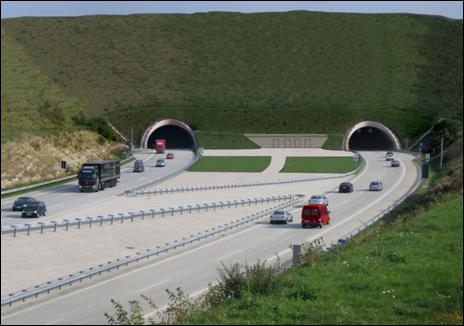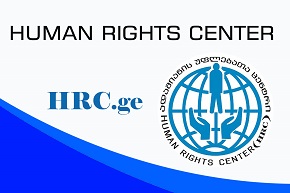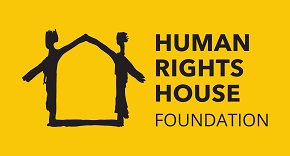Saba Tsitsikashvili
Huge construction of Ruisi-Igoeti freeway is underway. This project is continuation of the construction which started in 2006 and which is called “auto-ban”. Although only 60-70 kilometers of the auto-ban was built so far, the experts see serious faults in it and are doubtful about the construction of tunnels and Estacada.
The construction of the auto-ban started on March 15, 2006… initially “Zimo Ltd” built the 16-kilometer-long Natakhtari-Aghaiani motorway; then unknown company built 12-kilometer-long Aghaiani-Igoeti motorway. Israeli company “Ashtrom” built the 25-kilometer-long Igoeti-Sveneti freeway.
As for the Sveneti-Ruisi 15-kilometer-long motorway it is being constructed now. The construction started on July 15, 2009 and Azerbaijan Company “Accord” is busy on it.
The representatives of the transport department state that several hundred million USD is envisaged for the project. One third of the fund is allocated from the state budget and the rest is credit from the World Bank.
Construction of the Sveneti-Ruisi motorway is the most difficult part of the Tbilisi-Senaki-Leselidze motorway because it will consist of all kinds of road-engineer constructions. They should build two estacades (the length of each of them will be 877 meter and width 11, 5 meter), two parallel tunnels (the length of each of them 800 meter and width 11, 5 meter). The tunnel will be constructed in Austrian technology. This method is well-appropriated in the developed states of the world. They also build bridges, underground passages, capita, and water-channel pipes. Italian Todini has to build both tunnels.
The ministry of regional development and infrastructure of Georgia spread press-release which stated that the minister Davit Tkeshelashvili and the chairman of the transport department Ramaz Nikolaishvili monitored the construction activities of the Sveneti-Ruisi motorway on the place.
The ministry also reported that 6 bridges are to be constructed on Sveneti-Ruisi motorway: one over the Gori road, second over the Tortla River, the third over the road in Mejvriskhevi village, the forth over Mejuda River, fifth over Tskhinvali cross-road and the sixth one over Liakhvi River. Two parallel Estacada are the most important parts of this motorway over the River Liakhvi; its total length is 880 meters.
The road on Tbilisi-Senaki-Leselidze motor-way will be covered with cement-concrete which is appropriated in the developed states and are particularly strong.
The construction of the Sveneti-Ruisi part of the motorway is the most difficult in the history of modernization-construction activities of the transport roads in Georgia. It includes almost every sort of construction activities and is one of the most serious projects in the South Caucasus.
As we have seen they will cover the Sveneti-Ruisi part of the road with concrete too. We got in touch one of the experts to make comments on similar construction who wanted to keep his name anonymous and tried to explain the problem professionally.
“I am the most critical about the poor construction of this auto-ban and if anybody thinks that I am less glad with the construction is very mistaken. I have counted every meter of both constructed and unconstructed road and I perfectly know what kind of bridges and tunnels are being constructed there. I have travelled on the road to Igoeti and Gori so many times on the weekends that I cannot even count; I am glad like a child when I see well-designed infrastructural projects. Tens of my photos of the auto-ban are posted on the Russian forums. I am glad when people are proud with the auto-ban and when Georgian people show off before the forum-users from the post-soviet republics with the auto-ban and show my photos. I take every photo from the best side because I do not want our builders to be laughed at by Russians. But do you want me to keep silence in Georgia too?” said the expert.
During our conversation we found out several details which cause serious doubts about the value of the auto-ban. They are:
1. Soil of the auto-ban has lowered in several places and the road is concaved in several places;
2. the levels of auto-ban links are irregular; they are like springboards (western wing of Igoeti-Sveneti motorway);
3. during rain the water-ponds appear in some places of the auto-ban (near Gori);
4. Several parts of the auto-ban are badly drafted; it has turnings, rises and falls where they are not necessary (both wings of Igoeti-Sveneti road);
5. The western and eastern wings of the auto-ban are running equally on one relief; for example, if the eastern direction is running straight, the western direction rises and falls and then rises again (western wing of the Igoeti-Sveneti motorway is badly constructed; while the eastern part is better constructed).
6. The white lines on the auto-ban vanish in three months while the yellow lines made for the temporary movement are still stark. Apparently, the company which won the competition for painting the traffic-lines on the auto-ban, mercies the money for the paints and makes only thin lines. The result is the vanished lines in three months. As for the temporary lines for changing the movement direction because of the ongoing construction, they did not mercy the paint because it did not need much of it. You can observe yourself – none of those old temporary lines are vanished yet and they look fresher than the white traffic lines.
7. the light-posts are badly painted; some of them are not painted at all; others are only half-painted and rust is not removed from them.
8. In the divisor line the roots of the fur-trees are rammed by boots; they did not use spade and hoe at all; so 70 % of them are already dry.
This is the evaluation of the expert regarding the auto-ban. One of the builders told us those incidents they have encountered during construction. For example, “specialists” of the building company “Ashtrom” installed the machine components on the concrete-paver incorrectly and they paved the three-kilometer-long road with it. Then they saw waves on the road, could not understand what had happened and invited a specialist from Turkey. He went crazy – “what are you doing here?” he told them and changed the detail in the correct form and the waves disappeared.
“They mercied the construction materials when they built the basement. Grounded gravel was used only on binders and its thickness was only 50 centimeters. However, they paved the 80-centimeter sub-base with the mud taken from the mountains instead the grounded stones. The time will show the result of similar poor work but it is fact that this part of the road will went wrong soon. However, Natakhtari-Igoeti part of the road will keep in good condition 50 years without problems,” said the builder.
It is noteworthy that two variants of the tunnel-construction were being discussed. The information was published on a website by a person who is close to the authority and was aware of the road-construction activities. He wrote that according to the first variant the tunnel had to start soon after the bridge over the Liakhvi River and was to end near the Ruisi village.
They are constructing the tunnels according to the second variant. That means there will be lot of rises and falls before and after the tunnel.
The ministry reports that the first variant was much more expensive than the second one; so they chose the latter.
On May 14, 2010 the press-center of the ministry announced new details of the new construction. “Today, first in Georgia, we will start construction of the complex for relaxation and other services. The minister of regional development and infrastructure Davit Tkeshelashvili, head of transport department Ramaz Nikolaishvili and the chairman of the board of supervisors of the JSC Wissol Petroleum Georgia Soso Pkhakadze will attend the launching process of the complex construction on the E-60 motorway near the Gori pass.
The project aims to construct resort-zone, tourist information center, trading and public inns, auto-service center, bus and car parking zone, petrol station and sanitary-prophylactic service centers. Similar complexes are in modern freeway in the developed and part of developing countries.
The main part of the complex, which is being constructed by Wissol, will finish in autumn of 2010. The transportation department and the winning company Wissol signed the agreement on March 22, 2010.
As for the tunnel, Italian company “Todini” drafted the tunnel. On one of the websites we found the following statement: “The tunnel is being constructed by the “Accord” under supervision of the Company “Todini”. We suppose that 90 % of the job will be well-done but we have information that the Accord tries to spend as less money as possible on it. Only 5 000 out of total 60 000 axis are produced in Sweden; they wanted to use Chinese axis because the former was too expensive. I do not know what they will do at the end but they intended to spend less money,” wrote one internet-user. However, we cannot check the information.
With the support of “Transparency International –Georgia” we received the evaluation document of the impact of the freeway on the environment. Together with other important issues we will underscore several problems.
“Construction activities will have minimal impact on the natural environment according to the preliminary evaluation because the most part of the road runs across the agricultural territory part of which is covered with grass. The minimal impact means cleaning the area for the freeway from the plants. As for the impact on animals, it means the influence on the ictio-fauna in the process of bridge-construction.
The construction and usage of temporary roads, as well as usage of the more working space might damage the soil and cause potential erosion particularly in the slopping areas.
Particularly during the construction of the bridges, if the construction vehicles and equipment are out of order, the water and soil can be polluted.
The construction remains, if they are not thrown away in accordance to the environmental requirements, might negatively influence both the soil and river water in the process of bridge reconstruction. Despite the abovementioned factors, the project implementation has positive evaluation in the long-term perspective for the state development.
Regarding the reconstruction-widening of the bridges, the river-beds change their location temporarily and new channels are arranged for the fish with the maintenance of the necessary water flow (sanitary water); the vehicles working in the rivers are filled with fuel; quality of water in the river (Trtola, Mejuda, Pshana, Liakhvi); launching the control on river-beds; control of filling in fuel in the vehicles working on the terraces in order to avoid the accidental spill of fuel; to work out activities for the prevention of spilling the fuel. The contractor builder has to work out the prevention activities before the vehicles enter the rivers and the situation (fuel pipes, fuel tanks, etc) in the most vulnerable places shall be checked every day.
Article prepared within the project “Network of Journalists – for the Transparency of the International Aid for Georgia”. The project is implemented by the Association of Georgian Regional Media. The project is funded by the Charles Stewart Mot’s Foundation within the project of the German Marshal Foundation “The Black Sea Trust for Regional Cooperation”
News
December 13, 2023
Ethnic minorities outside the peace dialogue
November 6, 2023
‘Peace’ agenda of political parties
Popular
Articles
February 13, 2024




